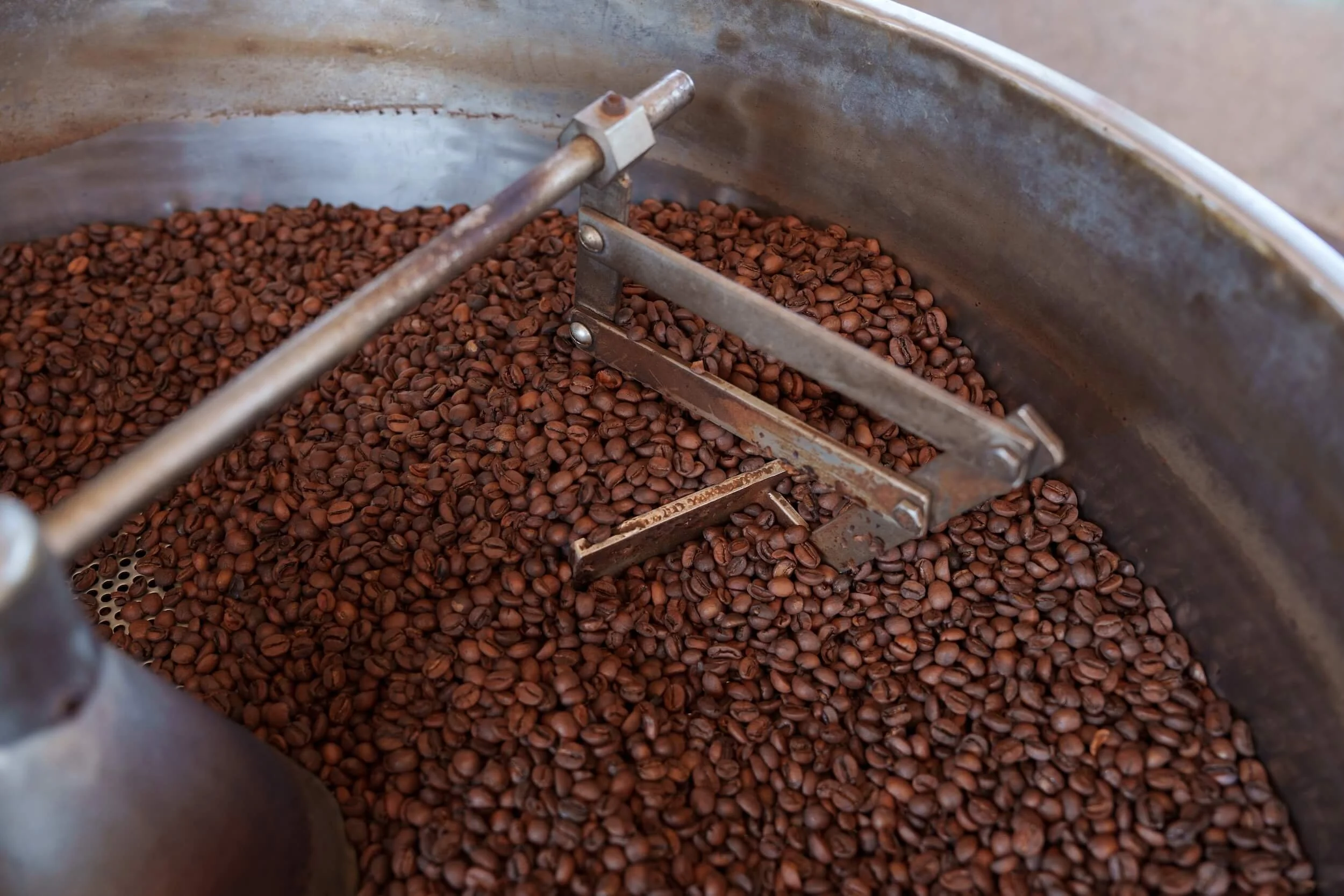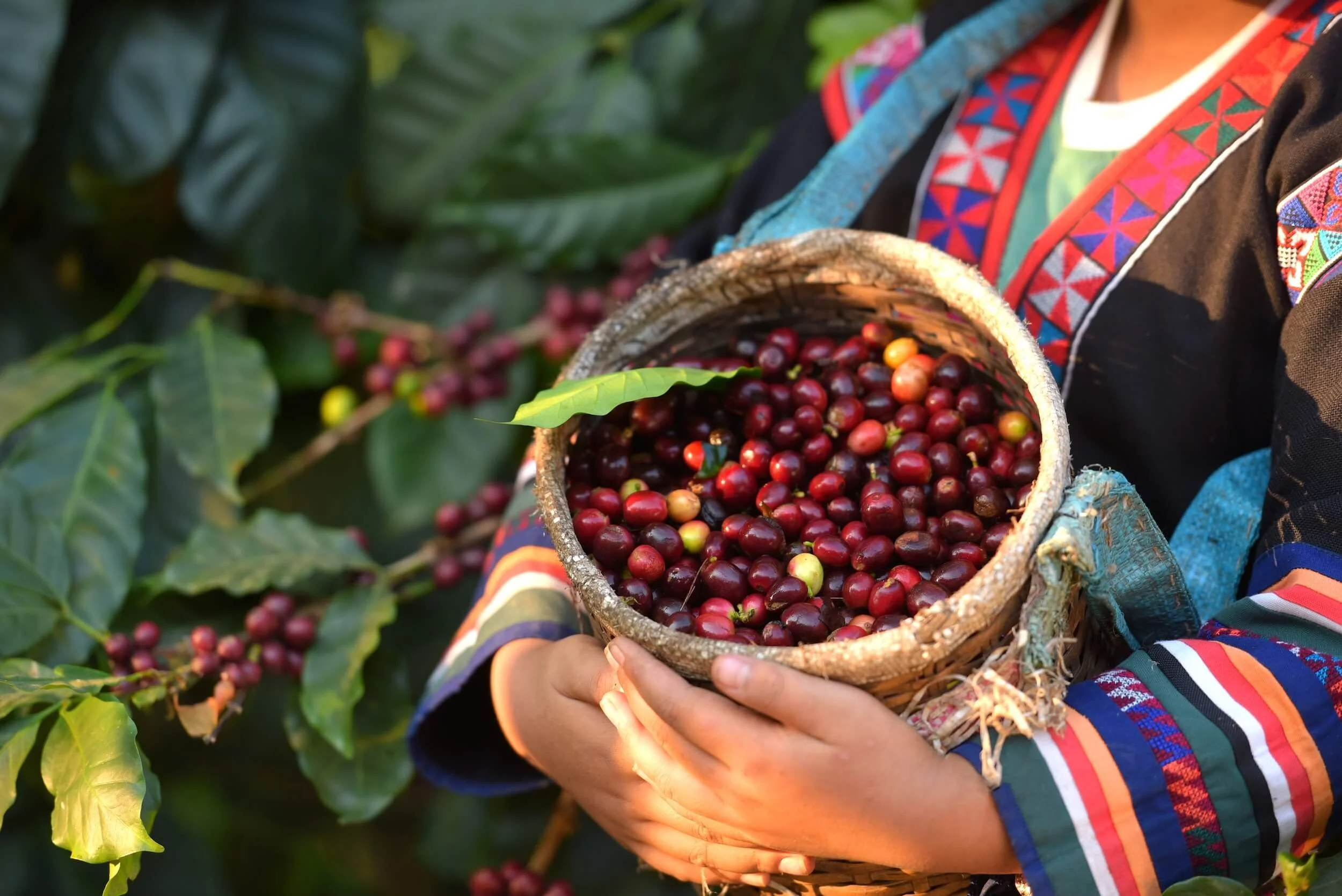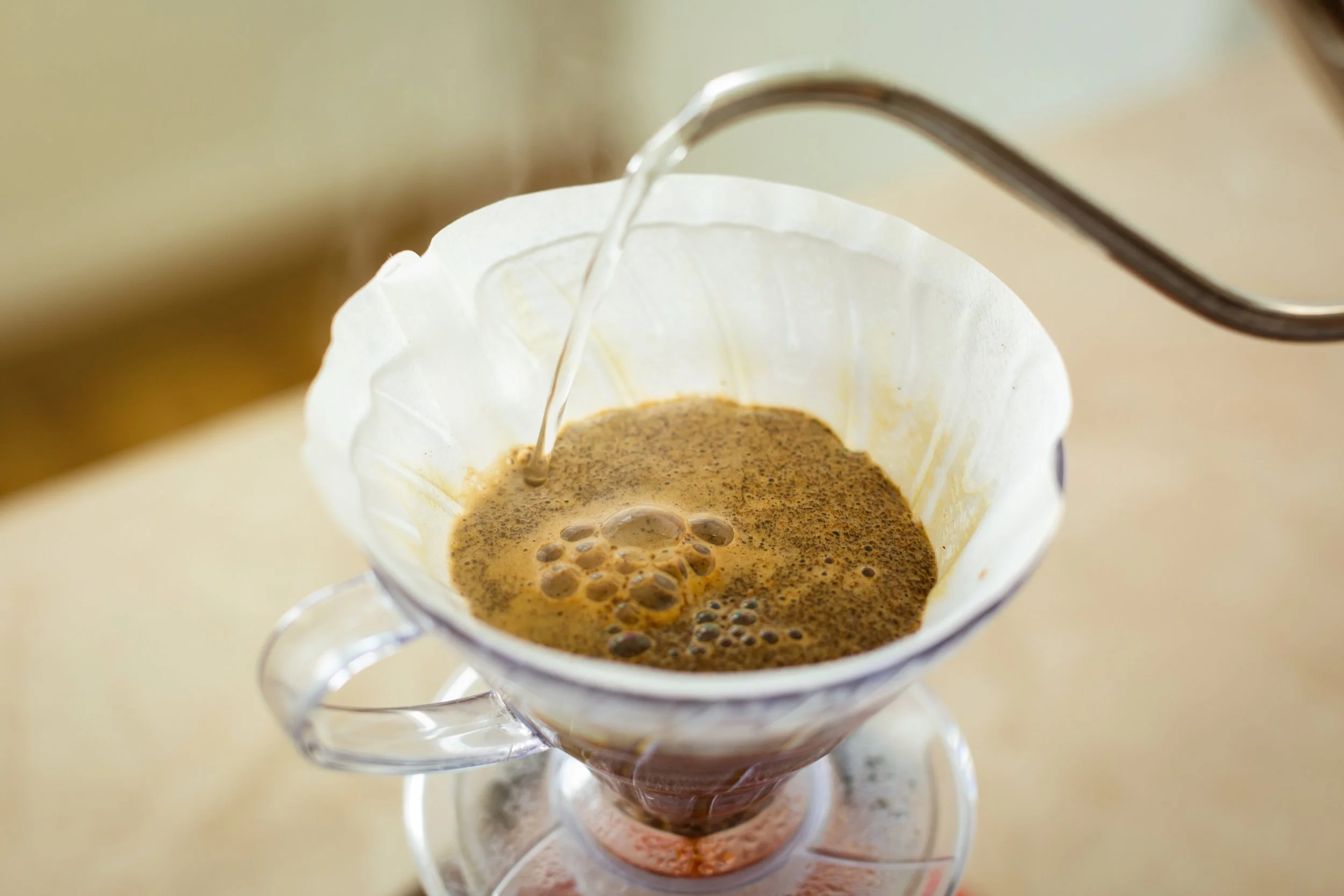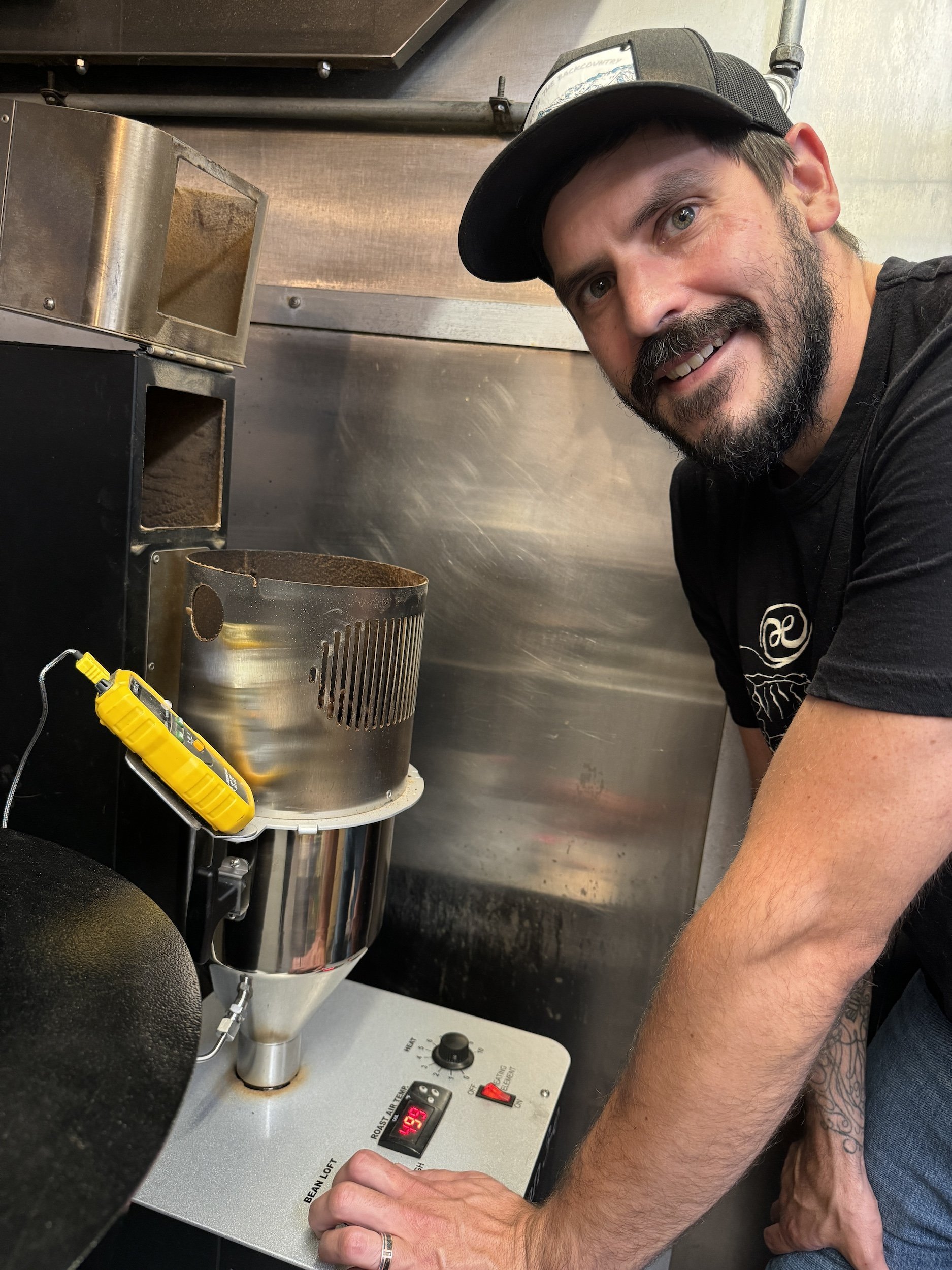The Surprising Benefits of Air-Roasted Coffee (and Why It Tastes So Different)
Learn what air-roasted coffee is and how it can impact the flavor and sustainability of your morning cup.
Hey Alaska! We know you love your coffee — and your ice cream, for that matter — but you might be missing out on the best part of your daily cup.
Most coffee you find in stores is roasted in a traditional metal drum, where beans tumble against hot steel until they’re done. But there’s another (dare we say, better?) way — one many consider brighter, smoother, and closer to the bean’s true flavor.
It’s called air roasting — and it’s our specialty.
In case we haven’t met, we’re Aethereal Coffee, an award-winning organic, fair-trade coffee roaster based right here in Palmer, Alaska. We’re all about the air roast (hence the name Aethereal, which literally means “air”).
That’s why we wrote this article: to explain what air-roasted coffee actually is — and how it can impact your taste buds, your health, and even the planet.
Ready to find out what you’ve been missing? Let’s dive in.
What is Air-Roasted Coffee?
So… let’s start with the basics: what does air-roasted coffee actually mean?
Here’s the gist: Most of the coffee you find in stores (yes, even here in Alaska) is roasted the old-fashioned way: beans tumbling against hot metal until they’re done. It’s called drum roasting.
Air roasting is a different method that suspends the beans in a stream of hot air.
Here’s generally how it works:
The beans are placed into a funnel-like machine, which blows air up from the bottom
The moving air surrounds each bean, heating them evenly on all sides.
The roaster pays close attention to the time and temperature that the beans are roasting to ensure ideal flavor.
The primary flavor benefit from air roasting is that the beans don’t make any direct contact with the metal used in drum roasting, which means there’s less risk of uneven roasting or burnt, charred flavors.
Here are three other key differences that set air roasting apart:
Chaff removal — During roasting, beans shed a thin, papery skin called chaff. In drum roasting, the chaff can smolder and add bitterness or smokiness. But in air roasting, it’s blown away into a chamber, keeping the flavor clean and bright.
Airflow control — Because the beans are floating, hot air reaches every surface evenly. This consistency makes each roast more predictable and uniform.
Precision with time and temperature — Air roasting gives roasters exact control over heat and timing. That precision means they can bring out the best qualities of each bean, batch after batch.
In short, while most store-bought coffee is roasted in a drum, air-roasted coffee offers a more even, controlled, and clean roast, setting the stage for a very different flavor experience.
Our customers always say, “It’s like heaven in a cup.” And to that, we agree!
Why Does Air-Roasted Coffee Taste Different?
Let’s take a deeper dive into the best part of air-roasted coffee: The flavor.
As we mentioned, with air-roasted coffee, the flavors of the bean itself shine through, rather than being masked by burnt notes or char that can happen during the drum-roasting process.
This is especially valuable when it comes to single-origin coffees, which are prized for their unique flavors (and are beloved by the fanciest of coffee consumers).
Single-origin coffee means the beans all come from one place, such as a single farm, a cooperative, or a defined region.
Coffee blends, on the other hand, combine beans from multiple origins. Roasters often create blends to create balance, consistency, or a “house flavor” that tastes the same year-round.
For example, our award-winning Espresso blend combines beans from Colombia and Uganda to create our signature house blend.
Now there’s nothing better or worse about single origin or a blend. It’s just that when you drink a cup of single-origin coffee, you’re also tasting the story of that region: the soil, the altitude, the climate, and the farming practices.
In other words, it’s fancy. And fun. And you can brag about your knowledge to your friends.
Air roasting single-origin OR beans for blends helps coffee roasters like us deliver the most vibrant flavor profile:
Clarity of taste: You can taste the unique origin notes — citrus, berry, chocolate, or honey — without interference from smoke.
Balanced acidity: Air roasting avoids the sharp sourness or harsh bitterness that sometimes shows up in drum roasts.
Stronger aroma: More of the natural compounds survive the roast, so your cup smells like fruit, flowers, or caramel instead of just “roasty.”
Consistency: Because every bean roasts evenly, you get the same reliable flavor every time.
Think of it this way: if drum roasting is like cooking over a campfire, air roasting is like cooking it in a convection oven. Both work — but one gives you more control and clarity. It’s next level.
If you consider yourself a connoisseur, air-roasted coffee should definitely be on your bucket list.
Air Roasting & Antioxidants: What You Should Know
Now, let’s talk about something you might not expect: how roasting impacts the natural compounds in your coffee, like antioxidants.
Coffee is naturally rich in antioxidants, and some research suggests that airflow and shorter roast times may help preserve more of those feel-good compounds in your cup. [1]
In case you didn’t know, antioxidants are compounds that help protect cells from everyday stressors. You’ll also find them in foods like blueberries, dark chocolate, and green tea.
While scientists are still studying their exact roles, antioxidants are widely recognized as contributing to overall wellness by supporting your body’s natural balance.
When you enjoy a cup of air-roasted coffee, you’re not just tasting the clarity of the bean — you may also be savoring more of its natural compounds, preserved by the gentle roasting process.
Here are two reasons why air roasting may help preserve the antioxidants in your morning cup:
Even Roasting, Fewer Hot Spots: With beans suspended in hot air, air roasting avoids possible scorching from a drum, reducing the chance of burned beans and degraded compounds.
Shorter Roasting Time: Air roasting typically finishes in 6–8 minutes, compared to 12–15 minutes for drum roasting. Less time under heat may mean more antioxidants survive the process.
So, is air-roasted coffee “healthier”? Not necessarily. Coffee isn’t a miracle cure, and everyone responds differently to it. But what we can say is that a cleaner, more precise roast may help preserve more of what’s naturally good in coffee.
That means with air-roasted coffee, your daily cup might taste better and support your well-being.
Coffee Sustainability & Air Roasting
You may be wondering if air-roasted coffee is a cleaner, more environmentally friendly method than drum roasting. The short answer is yes, it often can be.
Here’s why: During roasting, coffee beans naturally shed a thin outer layer called chaff. In traditional drum roasting, the chaff lingers inside the drum, where it often burns. This may create extra smoke and release more particulates into the air. [2]
With air roasting, the hot-air stream usually lifts the chaff away from the beans immediately and carries it into a separate collection chamber.
The result? A cleaner roast with less smoke in your cup — and a cleaner environment inside and around the roastery. Plus, because the chaff doesn’t burn, it can be collected and even composted, rather than turning into smoke and waste.
If you’re interested in sustainability, there’s another piece of the coffee puzzle to you’ll definitely want to look into: the beans themselves.
You may want to consider buying organic, fair-trade coffee since it supports farming practices that are proven to be more environmentally friendly than conventional coffee.
Here are three reasons why:
Sustainable Farming Practices: Fair trade coffee farmers are encouraged to use organic methods and crop rotation, which help maintain soil health and reduce erosion.
Reduced Chemical Use: By minimizing or eliminating harmful pesticides and fertilizers, fair trade growers protect ecosystems, create safer conditions for workers, and deliver a cleaner cup.
Biodiversity & Climate Impact: Many fair trade farms use agroforestry — growing coffee under the canopy of native trees — which helps conserve wildlife habitat and directs carbon dioxide back into the coffee plants instead of the atmosphere.
So when you choose air-roasted, fair trade coffee, you’re not only enjoying a cleaner roast — you’re also supporting farming practices that respect people, communities, and the planet. Which is exactly why we do what we do here at Aethereal.
Brewing Air-Roasted Coffee at Home
Now that you know how air roasting works and why it matters, let’s bring it back to the experience you care about most: how it tastes when you brew it at home.
The good news? You don’t need fancy equipment to notice the difference. Because air roasting produces a cleaner, more consistent bean, the results shine through no matter how you brew.
Here are 4 ways to do it:
Pour-over: Crisp, clear, and layered — the ideal method for highlighting subtle origin notes in single-origin beans.
Espresso: Sweet and balanced, with a smooth crema instead of the harsher bite you sometimes get from drum-roasted beans.
French press: Rich and full-bodied, but without the bitterness that uneven roasting can leave behind.
Drip coffee maker: Even your everyday morning cup tastes more vibrant and lively. Hello, Mr. Coffee. You’ve got yourself quite an upgrade!
Because the roast itself is cleaner and more even, brewing with air-roasted beans is surprisingly forgiving.
Even with a basic grinder and a simple setup, you’ll notice the difference right away: brighter flavors, smoother finishes, and a cup that consistently highlights what makes the bean unique.
An Award-Winning Air-Roast Right Here in Alaska
From cleaner flavors to sustainable practices, air-roasted coffee delivers benefits that are hard to ignore.
And why would you want to? Air-roasted coffee highlights the true character of single-origin beans, preserves more of what’s naturally good, and aligns with farming practices that respect both people and planet.
And if you’re wondering whether the difference really matters, the judges say yes. Aethereal Coffee has earned seven medals at The Golden Bean North America — the largest coffee roasting competition in the world.
Allow us to present our list of awards:
Espresso Blend, Espresso — 2018 Silver Medal Winner
Espresso Blend, Organic Espresso — 2018 Bronze Medal Winner
Nicaragua Roast, Pour Over Coffee — 2018 Bronze Medal Winner
Espresso Blend, Milk-Based (Latte) Espresso — 2023 Bronze Medal Winner
Nature Friendly, Milk-Based (Latte) Espresso — 2024 Bronze Medal Winner
Carbonic Maceration, Elite Coffee (Filter) — 2024 Bronze Medal Winner
Fruit Symphony, Pour-Over Filter — 2024 Bronze Medal Winner
These medals span categories from espresso to pour-over, proving that air-roasted coffee isn’t just a novelty — it stands up against the world’s best.
Ready to taste the difference? Try a bag of our award-winning, air-roasted coffee and experience it for yourself!
We’ve got a soul-warming bag of beans waiting for you here.
References
https://www.sciencedirect.com/science/article/pii/S2665927124001874
https://pmc.ncbi.nlm.nih.gov/articles/PMC7531227/?utm_source=chatgpt.com
https://www.mdpi.com/1996-1073/18/5/1018
Troy McGlashan monitors time and temperature during the air-roasting process.
FAQs About Air-Roasted Coffee
Is Air-Roasted Coffee Healthier Than Drum-Roasted Coffee?
Coffee is naturally rich in antioxidants and other beneficial compounds. Studies show that roast conditions like airflow, temperature, and roast level can influence how many of those compounds remain after roasting [1]. Because air roasting suspends beans in hot air for a shorter, more even roast, it may help preserve more of what’s naturally good in coffee compared to darker or uneven drum roasts.
That doesn’t mean it’s a miracle cure — but it does mean your daily cup could be a little cleaner and closer to what the bean itself was meant to offer.
What Makes Air-Roasted Coffee Taste Different?
Most store-bought coffee is drum roasted, where beans tumble against hot metal. That contact, plus lingering chaff that can burn during the process, may create smoky or bitter flavors [2]. In air roasting, beans float in a stream of hot air, which prevents scorching and carries the chaff away into a collection chamber.
The result? A smoother, cleaner cup where the natural flavors of single-origin and fair-trade coffee shine through.
Is Air-Roasted Coffee Less Acidic?
Many coffee drinkers describe air-roasted coffee as smoother and easier on the stomach compared to some drum-roasted coffees. That’s because the even heat of hot-air roasting reduces the risk of scorching or uneven roasting, which can sometimes create sharp, bitter, or overly acidic flavors.
That said, acidity in coffee is influenced by more than just the roast method — origin, altitude, and processing also play a role. So while air roasting often brings out a balanced, clean flavor profile, it doesn’t eliminate natural coffee acidity.
Does Air Roasting Change the Caffeine?
Nope — caffeine content in coffee comes primarily from the bean itself, not the roasting method. Both air roasting and drum roasting preserve caffeine levels, though roast degree (light vs. dark) can create small differences.
What air roasting does change is the clarity of flavor. By preventing charring and removing chaff quickly, it allows the natural profile of the bean to shine without masking bitterness — so your morning boost tastes as good as it feels.
Why Isn’t Air-Roasted Coffee More Common?
Drum roasters have been around for centuries and became the commercial standard because they can handle very large batches efficiently. That’s why most coffee you find on grocery store shelves has been drum roasted. Air roasting, by contrast, is usually done in smaller batches (like the way we do it) with more precise control over time, temperature, and airflow — which makes it less common, but also part of what makes the method so special.
Does Air-Roasted Coffee Cost More?
Sometimes, yes. Air roasting in small batches requires more attention, and when paired with organic, fair-trade sourcing, the cost per bag can be a little higher than mass-produced, conventionally roasted beans.
But here’s the bigger picture: those extra dollars don’t just pay for flavor. They help support farmers earning fair wages, fund community projects in coffee-growing regions, and protect ecosystems through sustainable farming. So the value goes far beyond the cup — even though the cup itself is pretty amazing.
Where Can I Buy Air-Roasted Coffee in Alaska?
If you’re in Alaska (or anywhere else), you can order freshly air-roasted coffee directly from us! In case we haven’t met, we’re Aethereal Coffee, based in Palmer, Alaska. Each batch is roasted just for you and designed to highlight the beans’ origin. Plus, we ship it to you quickly in a compostable bag. Ready to try your first bag?









